What separates market leaders from laggards in 2025? Operational efficiency is now the defining factor for enterprise success, determining how quickly organizations can adapt, scale, and deliver measurable outcomes. Enterprises that streamline workflows, remove bottlenecks, and coordinate tasks seamlessly gain a clear advantage, accelerating growth while unlocking scalable, predictable results.
AI agents are central to achieving this efficiency. By automating repetitive, time-intensive tasks across functions, they reduce errors, ensure consistency, and free human talent to focus on strategic priorities. Their capabilities form the foundation for reliable, high-performing operations that can adapt in real time.
Agentic frameworks provide the platform and infrastructure to deploy, manage, and scale these AI agents effectively across the enterprise. Acting as an orchestrator, the framework coordinates activities, integrates insights into workflows, and ensures actions align with organizational objectives, turning distributed automation into cohesive, high-impact outcomes.
This article explores agentic frameworks, their structure, capabilities, and benefits, and offers guidance on leveraging them to transform AI agents into enterprise-wide levers for operational excellence, efficiency, and scalable growth in 2025 and beyond.
What is an agentic framework
An agentic framework is an enterprise-grade platform that provides a structured, centralized environment to build, manage, and monitor multiple AI agents effectively at scale. Unlike individual Gen AI tools that perform isolated tasks, the framework serves as the foundational backbone, ensuring all agents operate cohesively, remain aligned with organizational objectives, and integrate seamlessly with existing enterprise systems. It transforms fragmented AI initiatives into a unified, governable ecosystem capable of delivering consistent, measurable impact across business functions.
At its core, the agentic framework empowers AI agents to operate in a coordinated, scalable, and strategically aligned manner. It provides governance, interoperability, and operational standards, effectively acting as the enterprise operating system for different types of AI agents. The framework defines rules, manages dependencies, and provides visibility into performance while allowing agents to act autonomously within clearly defined boundaries.
This platform-centric approach ensures that AI agents are autonomous, adaptable, and strategically aligned, while providing enterprise-wide governance and oversight:
- Autonomy with control: AI agents operate independently to execute tasks at scale, yet they adhere to enterprise-defined guardrails, compliance rules, and strategic objectives. This ensures automation delivers value confidently without compromising governance or alignment with business priorities.
- Human-in-the-loop for intelligent oversight: While AI agents can act autonomously, certain scenarios such as anomalies, exceptions, or high-impact decisions, require human judgment. By embedding a human-in-the-loop, the framework allows agents to seek human input when necessary, enabling review, guidance, and refinement. This integration not only maintains accountability but also helps continuously improve processes by incorporating human insights, ensuring AI actions remain precise, reliable, and contextually intelligent.
- Customization and enterprise-specific design: Built for your organization, the framework accommodates unique processes, workflows, legacy systems, specialized AI models, and proprietary business data. This ensures AI agents operate in the precise context of your enterprise, delivering highly relevant and actionable outcomes.
- Scalability and adaptability: Designed to evolve alongside your organization, the framework scales seamlessly as new data sources, advanced analytics, or expanded automation requirements emerge, maintaining performance, reliability, and alignment with enterprise priorities.
- Cross-agent orchestration: Multiple AI agents are coordinated to ensure insights, actions, and workflows are harmonized across teams, departments, and functions. With human-in-the-loop integrated, orchestration becomes both autonomous and accountable, combining machine efficiency with human judgment to drive smarter, more precise enterprise outcomes.
In essence, the agentic framework provides the platform and governance that turns independent AI agents into a cohesive, enterprise-wide capability. It enables organizations to transform data into coordinated, high-impact actions, optimize operational efficiency, and accelerate decision-making, all while maintaining full control, transparency, and strategic alignment.
Core components of an agentic framework
An agentic framework’s strength lies in its core components, which collectively enable AI agents to operate intelligently, autonomously, and at scale across the enterprise. These building blocks transform AI from isolated tools into a unified system, empowering agents to drive complex business outcomes with precision, agility, and strategic alignment.

Intelligent agents
These are specialized AI entities tailored to specific business processes such as customer service workflows, supply chain operations, regulatory compliance procedures, and more. Each agent operates autonomously within its domain, leveraging deep contextual knowledge to execute tasks, respond to evolving scenarios, and optimize decisions effectively, becoming digital experts embedded in the enterprise fabric.
Reasoning and orchestration layer
At the helm of the framework is the reasoning and orchestration layer, which acts as the strategic conductor. It synthesizes inputs from diverse agents, applies advanced context-aware reasoning, and orchestrates coordinated actions across the enterprise. This layer ensures that decision-making is coherent, aligned with organizational goals, and adaptive to dynamic business environments.
Learning and feedback loops
Continuous improvement is inherent to the framework, driven by robust learning and feedback mechanisms. Through reinforcement learning and outcome-driven feedback, the system evolves in real time, refining agent behaviors, enhancing accuracy, and aligning responses with shifting market conditions and customer needs.
Enterprise integration
Seamless AI integration with existing enterprise systems, including ERP, CRM, IoT platforms, cloud infrastructure, and data ecosystems, is foundational. This ensures agents have access to accurate, comprehensive information and can initiate actions across the technological landscape, creating a holistic and synchronized operational environment.
Together, these core components form the foundation of an effective agentic framework enabling enterprises to transcend traditional automation, harness adaptive intelligence, and unlock sustained competitive advantage in an increasingly complex business landscape.
Reference architecture & framework options
Implementing an agentic framework begins with a thoughtfully structured foundation that ensures every component operates in harmony. This foundation aligns AI agents, processes, and workflows, creating the necessary conditions for autonomous, intelligent, and coordinated action.
Once the foundation is in place, a reference architecture provides the blueprint for scaling these capabilities. It offers a standardized framework to orchestrate data, intelligence, and action across the enterprise, enabling seamless integration across data ingestion, reasoning, task execution, and feedback loops. This ensures AI-driven decisions remain consistent, reliable, and adaptable as the system evolves.
Purpose of reference architecture
Reference architecture serves as the strategic backbone of any agentic framework. It offers a clear, repeatable structure for integrating core components, helping organizations avoid fragmented deployments or operational silos. By defining the relationships between data sources, analytic engines, decision-making modules, and execution pathways, it enables organizations to unify intelligence and automation under a cohesive system. This alignment drives faster decision-making, higher operational efficiency, and measurable business outcomes.
Architectural layers and interactions
An effective agentic reference architecture is typically structured across multiple layers.
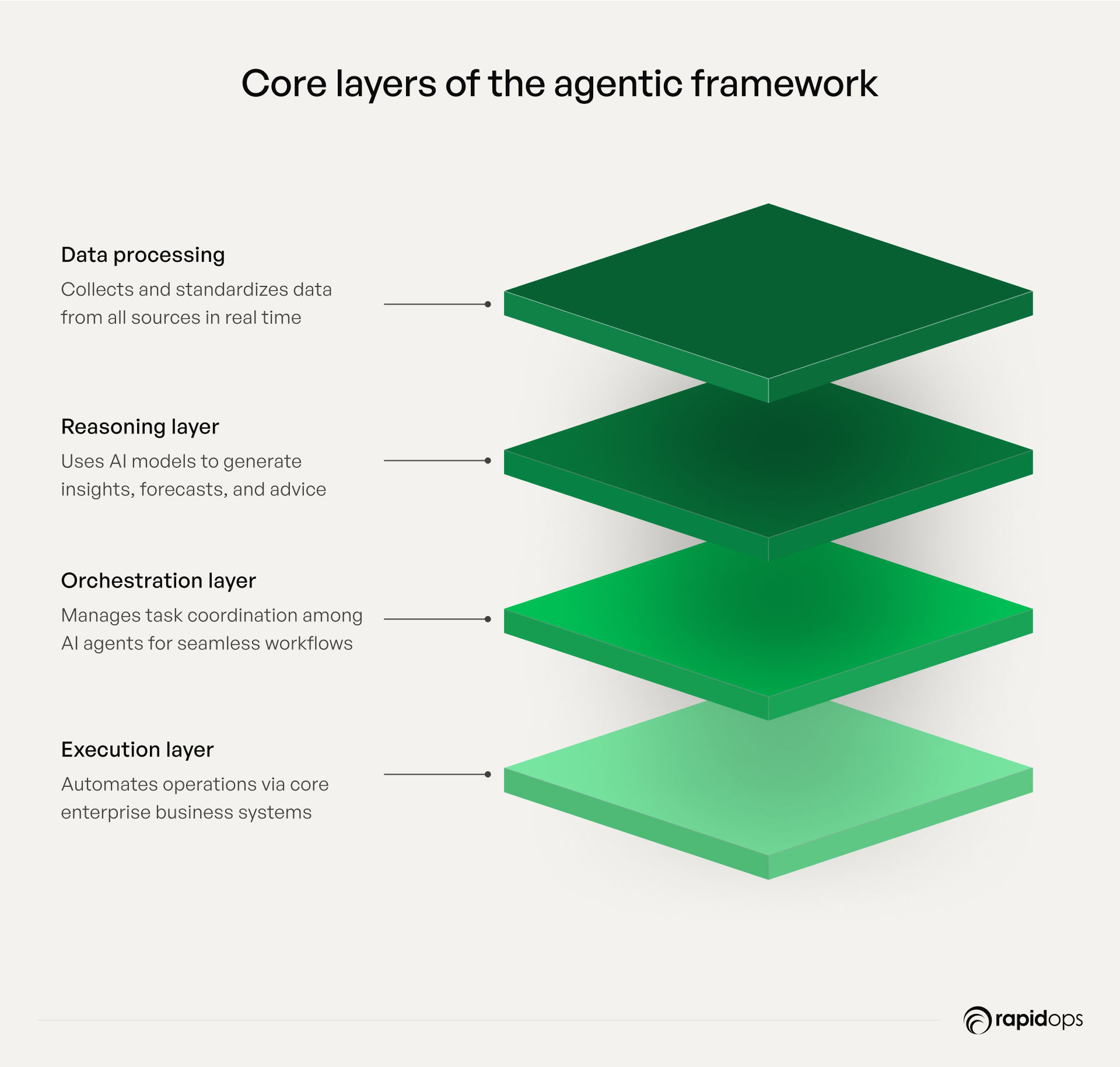
- Data processing layer: Ingests, cleanses, and standardizes data from diverse internal and external sources.
- Reasoning and intelligence layer: Applies AI and machine learning models to generate insights, product recommendations, and predictive actions.
- Orchestration layer: Coordinates tasks across AI agents, ensuring each decision triggers the appropriate downstream actions.
- Execution layer: Interfaces with operational systems, automating workflows, and delivering real-world outcomes.
Data flows seamlessly through these layers, allowing decisions to be informed, timely, and actionable. A structured design ensures that intelligence is not siloed but systematically converted into operational impact.
Framework options
Businesses today have access to a range of frameworks that support agentic AI architectures:
- Custom-built frameworks: Designed specifically for an organization, custom frameworks provide complete flexibility to align AI agents with unique business processes, workflows, and complexities. They enable enterprises to create a platform fully tailored to operational needs, ensuring maximum control, extensibility, and long-term adaptability.
- Open-source options: Platforms like LangChain and AutoGen offer flexibility, community-driven innovation, and rapid experimentation. These frameworks are ideal for organizations seeking agility and customization at lower upfront cost.
- Enterprise-grade platforms: IBM Watson, Microsoft Azure, and other commercial solutions provide robust security, scalability, and integration with enterprise IT systems. These frameworks are well-suited for organizations prioritizing compliance, reliability, and long-term support.
Each option presents trade-offs in terms of ease of integration, extensibility, cost, and operational control. Understanding these nuances is critical to selecting the right fit for organizational goals.
Selecting the right framework
Choosing an agentic framework requires evaluating multiple dimensions: business scale, existing technology landscape, integration complexity, security requirements, cost structures, and future adaptability. Among the available options, custom-built frameworks often provide the greatest strategic advantage, offering complete alignment with unique enterprise processes, workflows, and operational nuances.
By designing the platform specifically for the organization, enterprises gain maximum flexibility, seamless integration with legacy systems, and the ability to evolve as AI initiatives expand. Selecting the right framework, particularly a tailored, custom-built solution, ensures smooth adoption, avoids redundant investments, and positions the enterprise to scale AI-driven initiatives confidently while maintaining control, reliability, and strategic alignment.
How agentic frameworks work
An agentic framework provides a dedicated platform for enterprises to build, manage, and monitor multiple AI agents in a single, integrated environment. These frameworks are tailored to the organization’s unique systems, enabling seamless integration with ERP, CRM, IoT, and other data ecosystems. By providing governance, orchestration, and operational structure, the framework allows enterprises to transform fragmented data and workflows into coordinated, intelligent action, once AI agents are created and deployed on it.
Input & context capture
When using an agentic framework, enterprises first design and deploy AI agents tailored to specific functions, whether for customer service, supply chain, or analytics. Once built, these agents can be configured to contextualize data from internal systems, sensor networks, and external sources such as market trends or partner information. The framework ensures this data is standardized, organized, and made accessible across agents, providing a consistent context for decision-making.
Agent reasoning
With agents deployed, the framework facilitates reasoning and analysis by providing shared access to relevant data, rules, and organizational context. Each agent interprets inputs within its functional domain, identifies patterns, and anticipates potential outcomes. The platform ensures that insights generated by individual agents are coordinated and aligned with enterprise objectives, allowing the organization to leverage collective intelligence effectively.
Orchestration layer
A central orchestration layer within the framework manages agent interactions, coordinates tasks, resolves conflicts, and aligns outputs toward strategic goals. This ensures that agents work cohesively across departments and geographies, transforming individual insights into unified, high-impact enterprise actions.
Decision & execution
The framework supports execution by enabling agents to apply insights directly to operational systems or present structured recommendations for human oversight. Users can configure automated triggers, workflow adjustments, and alerts, ensuring that actionable intelligence is applied efficiently, consistently, and in alignment with business priorities.
Feedback loop
Every outcome generated by the agents is captured and fed back into the platform, allowing continuous refinement of models and workflows. This feedback loop ensures that both the framework and the agents evolve over time, improving predictive accuracy, operational effectiveness, and adaptability to changing business conditions.
Intelligent inventory management
An agentic framework provides the structured environment and orchestration capabilities that enable intelligent inventory management at scale. While autonomous agents execute tasks such as monitoring stock levels or predicting demand, the framework ensures that these agents operate in a coordinated, consistent, and governed manner across the enterprise. It defines workflow rules, integrates agents with ERP and supply chain systems, and standardizes decision protocols, so actions taken by agents are aligned with overall business objectives. Feedback loops embedded in the framework capture outcomes from agent actions, allowing continuous refinement of processes, ensuring inventory strategies remain adaptive, efficient, and reliable across the organization.
The framework enables, governs, and orchestrates the activities of agents, it does not perform the inventory tasks itself, but provides the environment for coordinated, intelligent, and scalable operations.
Capabilities of an agentic framework
Agentic frameworks empower enterprises to turn intelligence into coordinated, high-impact action by orchestrating autonomous agents, adaptive workflows, and continuous learning mechanisms. The framework ensures alignment wherever it drives value, connecting agents at critical points in workflows, decisions, or data interactions. This orchestration enhances strategic alignment, maintains compliance, and improves operational efficiency, enabling enterprises to make faster, smarter, and more informed decisions.
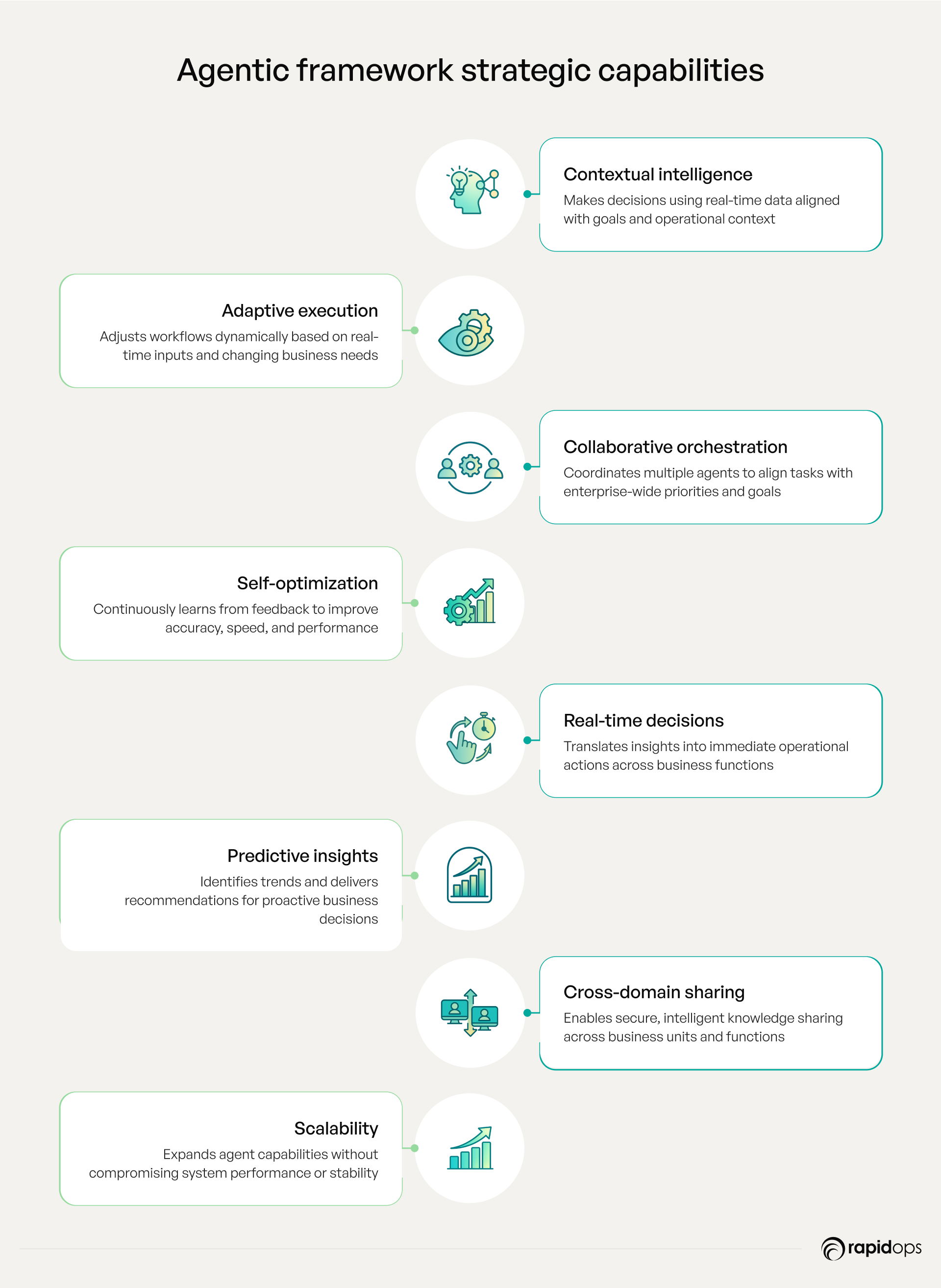
Contextual intelligence at scale
At the core of an agentic framework is contextual intelligence that informs framework-level decision-making. By synthesizing data from diverse internal and external sources, transactional systems, market trends, and partner networks, the framework enables agents to act cohesively. Each action is guided not just by isolated agent logic but by enterprise-wide priorities, ensuring outcomes are strategically aligned, timely, and actionable.
Adaptive execution and workflow orchestration
The framework continuously adjusts workflows and orchestrates agent activities in response to evolving business conditions. Whether managing supply chains, customer interactions, or resource allocations, adaptive execution ensures processes remain resilient, optimized, and efficient. The framework allows enterprises to respond proactively to disruptions or opportunities, maintaining operational continuity across functions.
Collaborative orchestration of agents
Multiple autonomous agents function as part of a unified ecosystem under the framework’s orchestration layer. The framework coordinates agent actions, resolves conflicts, and aligns tasks with enterprise objectives. This collaborative orchestration transforms independent agent activity into synchronized, enterprise-level intelligence, producing outcomes that surpass individual agent capabilities.
Self-optimization and continuous learning
Agentic frameworks incorporate real-time learning loops that continuously refine both agent behaviors and orchestration strategies. By analyzing performance outcomes, predictive models, and operational metrics, the framework evolves over time, enhancing accuracy, foresight, and efficiency at the enterprise level. This ensures intelligence grows alongside organizational complexity and market dynamics.
Predictive and prescriptive insights
Beyond historical analysis, the framework leverages agent collaboration to generate predictive and prescriptive intelligence. This empowers enterprises to anticipate trends, identify emerging risks, and optimize resource allocation, ensuring proactive and informed decision-making across all levels.
Real-time decision-making
By integrating reasoning, orchestration, and execution layers, the framework enables instantaneous decision-making across the enterprise. Intelligence flows seamlessly from insights to operational action, reducing latency and ensuring all agent-driven activities support strategic objectives in real time.
Enterprise-wide scalability
The modular architecture of an agentic framework allows organizations to scale agent operations efficiently across functions, business units, and geographies. This ensures consistent performance, operational excellence, and the ability to expand AI-driven initiatives without disruption.
Cross-domain knowledge sharing
The framework fosters knowledge exchange across departments and domains, enabling agents to leverage insights discovered elsewhere in the enterprise. This cross-domain intelligence drives cohesive strategies, innovation, and faster, more informed decision-making, amplifying the impact of each insight.
The true capability of an agentic framework lies in its orchestration, governance, and scalability of autonomous agents, turning fragmented intelligence into unified, actionable enterprise outcomes. By aligning agents, workflows, and data-driven insights across the organization, the framework enables faster, more accurate decisions, optimized operations, and sustainable competitive advantage, demonstrating the transformative power of coordinated intelligence at scale.
Benefits of agentic frameworks driving enterprise transformation
The true strength of agentic frameworks lies in their ability to unify fragmented AI efforts into a single, enterprise-wide intelligence engine. While AI agents perform tasks autonomously, the framework acts as the orchestrator, ensuring their actions are strategically aligned, integrated across systems, and scaled to deliver measurable business impact. By providing structure, governance, and adaptive workflows, agentic frameworks convert isolated AI capabilities into unified outcomes that advance operations, strategy, customer engagement, and workforce empowerment.
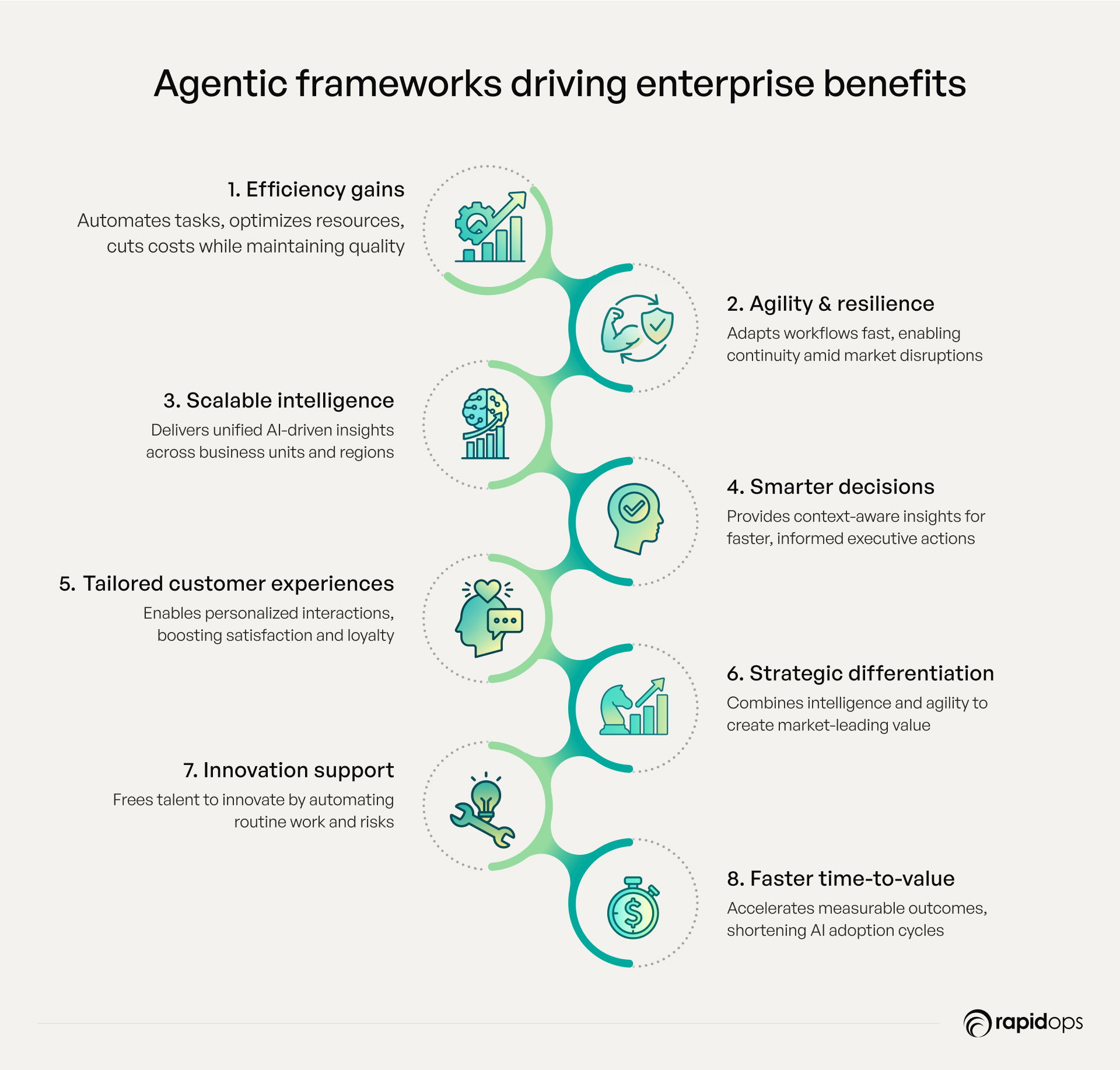
1. Efficiency & cost savings
Through orchestrated automation and workflow optimization, agentic frameworks streamline complex operations. By coordinating AI agents to execute tasks within defined enterprise parameters, these frameworks reduce manual intervention, optimize resource allocation, and cut operational overhead. Freed resources can then focus on high-value initiatives, while processes operate faster, more accurately, and with lower cost delivering immediate, tangible efficiency gains.
2. Agility & resilience
Agentic frameworks dynamically adjust workflows and priorities in response to evolving conditions. By providing a coordinated structure for AI agents and enterprise systems to respond in real time, organizations can maintain operational continuity, pivot strategically, and capitalize on emerging opportunities. This ensures resilience in volatile markets and gives executives confidence in rapid, informed decision-making.
3. Scalable intelligence
Frameworks allow AI-driven insights to flow across business units, geographies, and functions in a unified, governed manner. By coordinating multiple agents under a central system, the framework ensures decisions are informed by enterprise-wide data, aligned with strategic objectives, and consistently actionable. Leaders can scale intelligence confidently, reduce silos, and foster a culture of enterprise-wide data-informed decision-making.
4. Enhanced decision-making
By integrating context-aware intelligence directly into operational workflows, agentic frameworks enable faster, more informed decisions. Rather than relying solely on individual AI agents, the framework synthesizes their outputs into actionable insights, allowing executives to anticipate outcomes, mitigate risks, and align tactical actions with strategic goals. Every operational move becomes measurable, repeatable, and strategically aligned.
5. Strategic differentiation
By combining orchestration, intelligence, and automation, agentic frameworks enable enterprises to innovate with purpose. Coordinated AI agents execute initiatives within the framework, creating unique value propositions, faster market response, and operational excellence. The enterprise gains a long-term competitive advantage while ensuring every innovation is aligned with strategic objectives.
6. Innovation enablement
Structured frameworks free human talent from repetitive tasks, allowing creativity and strategic initiatives to flourish. By governing AI agents’ experimentation and pilot programs, organizations can safely test new business models, improve processes, and foster a culture of continuous innovation, all while minimizing operational risk.
7. Operational transparency
Agentic frameworks provide real-time visibility into processes, agent actions, and decision outcomes. Executives can monitor initiatives, identify inefficiencies, and implement improvements confidently. By standardizing oversight, the framework ensures accountability, governance, and measurable performance improvement across the enterprise.
8. Employee empowerment
By orchestrating AI agents to handle routine work, frameworks enable employees to focus on strategic, high-impact tasks. Leaders benefit from a more engaged, productive workforce capable of innovation, decision-making, and value creation, all supported by coordinated, intelligent automation.
9. Faster time-to-value
Framework-driven orchestration ensures intelligence is applied where it delivers the most impact. By embedding agent actions into enterprise workflows, outcomes, from operational efficiency to revenue growth, are realized faster. Executives experience accelerated ROI, with transformation achieved more quickly than through uncoordinated or siloed AI deployments.
How agentic frameworks transform enterprises
Imagine a sprawling enterprise where teams work tirelessly, yet insights remain scattered and decisions slow. Suddenly, autonomous AI agents step in, each mastering its own domain. An agentic framework orchestrates them like a skilled conductor, turning isolated efforts into a symphony of coordinated action. Processes flow seamlessly, decisions become faster and smarter, and the enterprise begins to operate with clarity and precision it never had before.
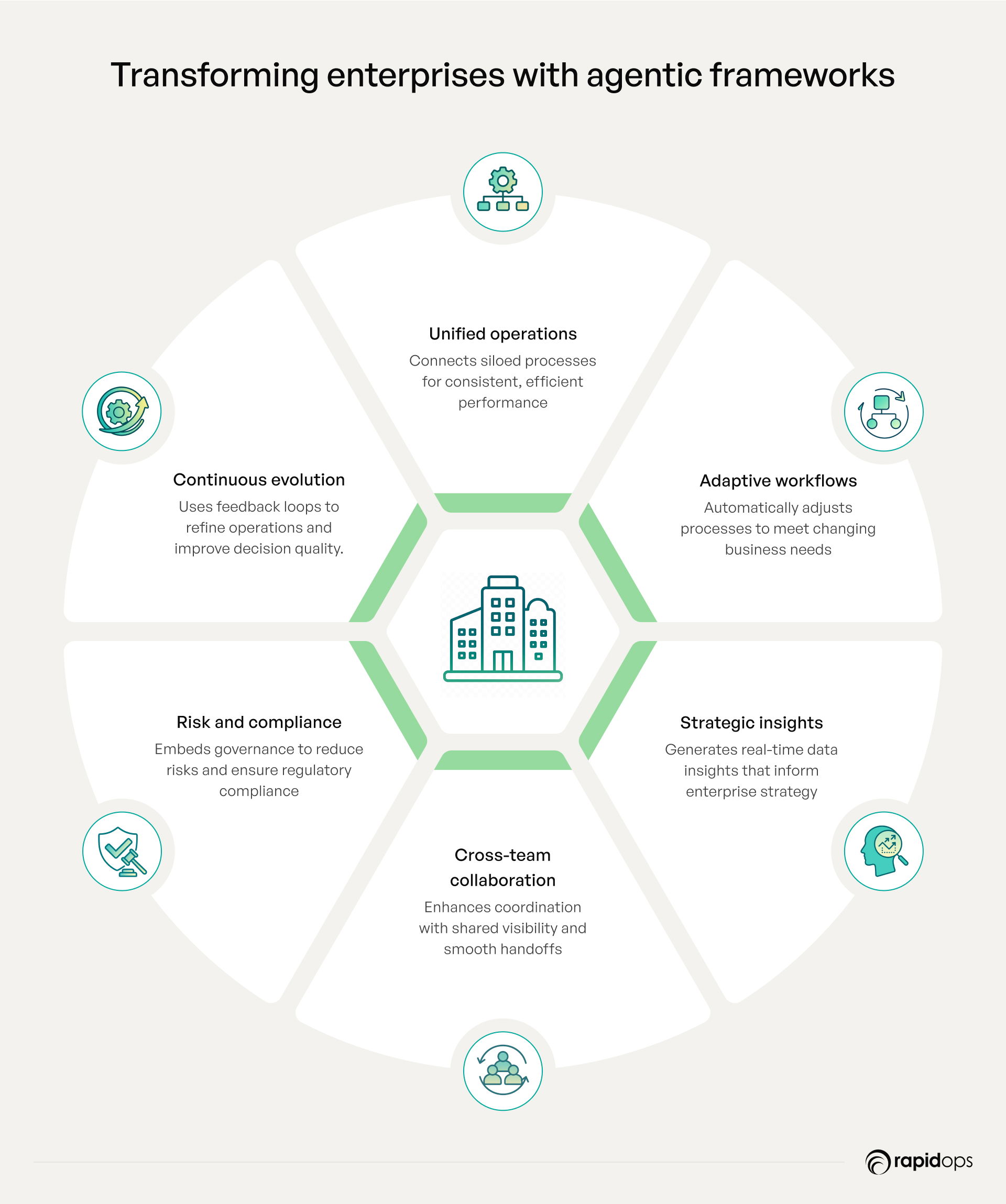
Enterprise-wide process orchestration
Agentic frameworks connect previously siloed processes, ensuring operations across departments and geographies work as a unified system. By intelligently coordinating workflows, dependencies, and decision points, organizations achieve consistent, efficient, and scalable operations, eliminating bottlenecks and enhancing operational visibility.
Adaptive organizational workflows
Workflows automatically adjust in response to changing business conditions, market trends, or operational disruptions. This dynamic adaptability allows enterprises to stay aligned with strategic objectives while minimizing manual intervention, ensuring processes remain effective and responsive at all times.
Data-driven strategic insights
By consolidating and analyzing real-time data from multiple sources, agentic frameworks generate actionable insights that inform enterprise strategy. Leaders gain visibility into operational performance, resource utilization, and emerging trends, enabling decisions that drive sustainable growth and long-term value.
Cross-functional collaboration
Intelligent agent coordination fosters seamless collaboration across teams and departments. Shared visibility and automated handoffs reduce friction, accelerate project execution, and ensure that initiatives are synchronized across the enterprise, enhancing overall organizational alignment.
Proactive risk and compliance management
Agentic frameworks embed governance into operational workflows, anticipating potential risks and ensuring compliance with regulatory and internal policies. Automated oversight reduces exposure to operational, financial, or compliance risks while providing audit-ready documentation for transparency.
Continuous learning and enterprise evolution
Feedback loops capture outcomes from every process and decision, refining models and workflows over time. This continuous learning approach allows enterprises to evolve dynamically, improve efficiency, enhance decision-making, and maintain a competitive edge in an ever-changing business landscape.
How to choose the right agentic framework
Selecting the right agentic framework is a strategic decision that directly impacts enterprise agility, operational efficiency, and long-term transformation. Choosing wisely ensures that autonomous agents operate cohesively to drive meaningful outcomes while scaling across the organization.
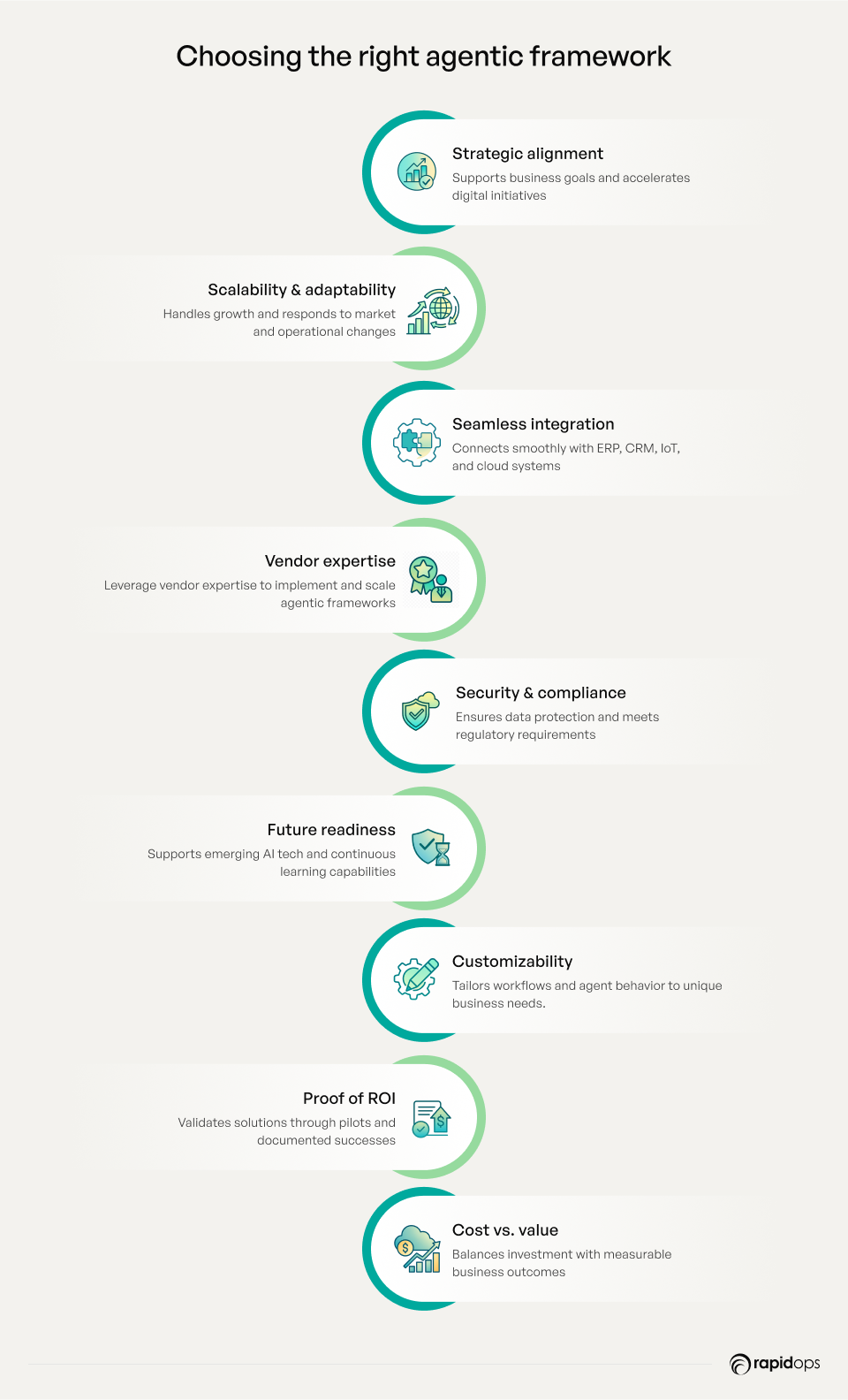
1. Strategic alignment
The true value of an agentic framework lies in its ability to be tailored to your enterprise’s unique operations. By selecting or building a framework that aligns precisely with your business processes, organizations gain the capability to deploy AI agents designed to automate complex, high-impact workflows. This ensures that AI-driven actions are not only efficient but directly support strategic priorities, optimize resources, and deliver measurable outcomes across the organization.
2. Scalability & adaptability
Enterprises evolve rapidly, and so must their frameworks. Select a solution capable of handling growing data volumes, additional agents, and expanding workflows without compromising performance. Adaptable frameworks can respond to market shifts, operational changes, and business expansions, ensuring sustained relevance and long-term value.
3. Seamless integration
Integration with ERP, CRM, IoT, and cloud platforms is essential for creating a unified operational ecosystem. Effective frameworks enable real-time data flows, synchronized decision-making, and consistent execution across functions, preventing silos and enabling enterprise-wide intelligence.
4. Security & compliance
Robust security measures and regulatory alignment are non-negotiable. Frameworks must guarantee data confidentiality, integrity, and compliance with industry-specific regulations. Enterprises reduce operational risks while enabling adoption at scale, ensuring that every agentic action is secure, auditable, and trustworthy.
5. Vendor expertise
Choosing an agentic framework demands evaluating the vendor’s proven experience in implementing complex frameworks, not just their company reputation. Vendors with deep expertise ensure seamless integration, anticipate adoption challenges, and provide guidance tailored to your enterprise, enabling the framework to deliver scalable, reliable, and high-impact results.
6. Customizability
Frameworks must reflect unique business processes, operational nuances, and strategic priorities. Customizable workflows, orchestration logic, and agent behavior allow enterprises to tailor the framework to specific use cases, ensuring it addresses real-world challenges rather than providing a generic, one-size-fits-all solution.
7. Future readiness
A future-ready framework supports continuous learning, emerging technologies, and advanced AI capabilities. Enterprises gain the flexibility to expand agent functions, integrate next-generation models, and stay ahead of evolving market demands, safeguarding long-term competitiveness.
8. Cost vs. value
Assess the total cost of ownership relative to expected business outcomes. Effective frameworks balance upfront investment with measurable benefits, ensuring that AI initiatives generate ROI while supporting strategic growth, operational efficiency, and enterprise-wide impact.
9. Proof of ROI
Prioritize frameworks with validated results from pilots, case studies, or references. Evidence of tangible outcomes provides confidence that the solution can deliver enterprise modernization, reduce adoption risks, and support informed investment decisions.
Key considerations for adopting agentic frameworks
Adopting an agentic framework is more than a technological initiative; it is a strategic enabler that reshapes enterprise decision-making, operational efficiency, and long-term growth. Successful adoption requires a holistic view across people, processes, and technology, ensuring every autonomous agent operates in harmony with enterprise objectives.
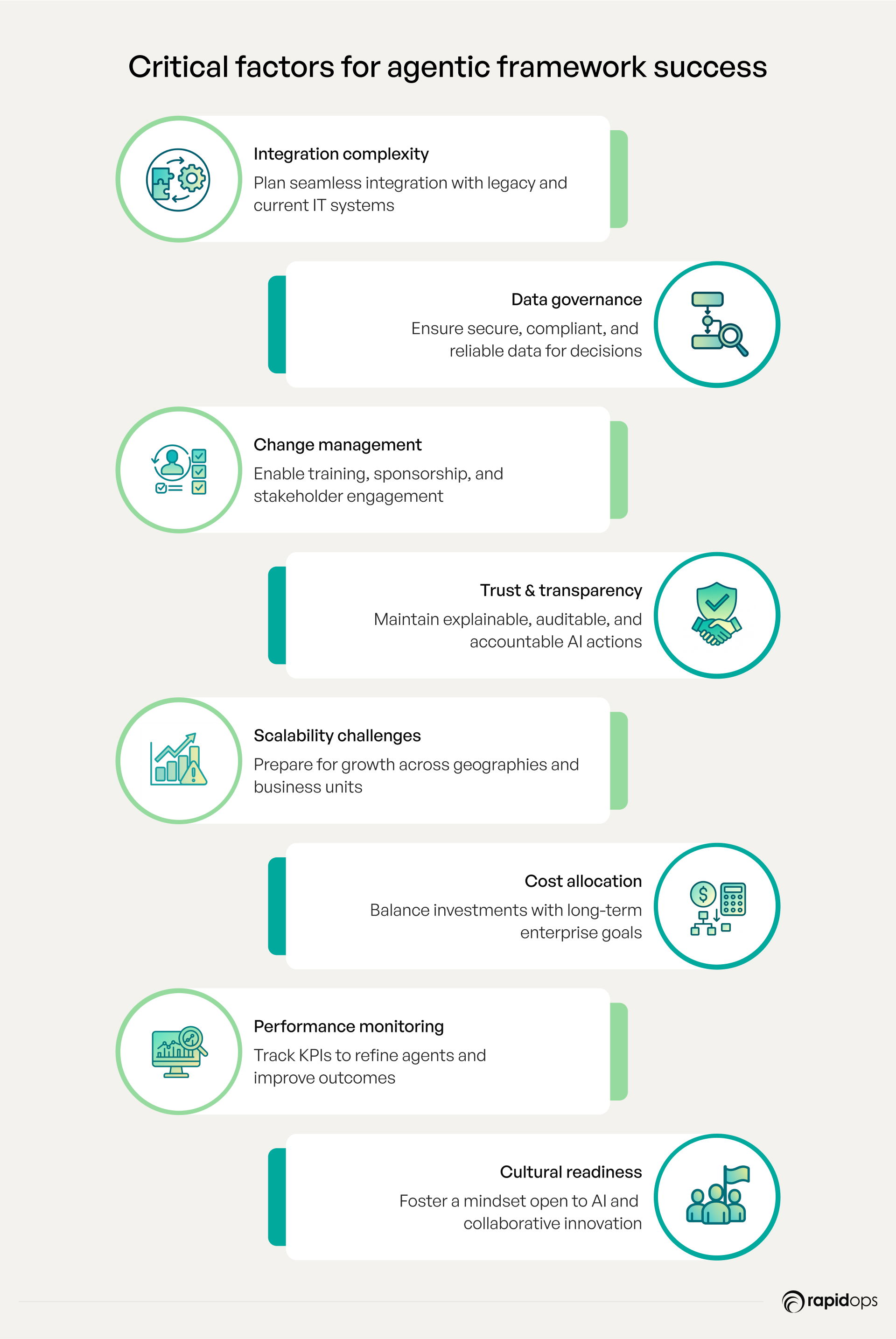
Integration complexity
Seamless integration with existing IT landscapes, legacy systems, and workflows is critical. Evaluating dependencies and potential friction points upfront ensures that agentic frameworks complement current infrastructure rather than disrupt it. Well-planned integration allows real-time data flows, coordinated agent actions, and faster adoption without operational downtime.
Data governance and security
High-quality, secure data underpins effective agentic frameworks. Organizations must implement robust governance policies, ensure regulatory compliance, and monitor data lineage continuously. This ensures agents make decisions on reliable, trustworthy data, reducing operational risk and fostering confidence across leadership and stakeholders.
Change management
Cultural and operational readiness is essential for adoption success. Structured programs that include executive sponsorship, employee training, and stakeholder engagement create an environment where teams understand the framework’s value and can leverage it effectively. Anticipating resistance and proactively addressing it accelerates adoption and maximizes organizational impact.
Trust and transparency
Decision-making by autonomous agents must be explainable, auditable, and accountable. Providing visibility into agent reasoning, bias mitigation mechanisms, and clear reporting ensures executives and operational teams can rely on the framework confidently, maintaining trust while supporting innovation.
Scalability challenges
Agentic frameworks must deliver consistent performance across multiple geographies, departments, and operational functions. Planning for computational, data, and process scalability ensures the framework can handle increasing complexity without bottlenecks, enabling enterprise-wide adoption and future growth.
Cost and resource allocation
Investments in agentic frameworks must balance immediate needs with long-term enterprise objectives. Evaluating resource requirements, implementation costs, and expected ROI ensures strategic allocation of budget, talent, and infrastructure while preventing overextension and ensuring measurable benefits.
Performance monitoring
Continuous measurement of KPIs and outcomes is vital for sustaining value. By tracking agent efficiency, decision accuracy, and business impact, enterprises can refine workflows, enhance agent behaviors, and ensure that adoption translates into tangible improvements in operations and strategy.
Cultural readiness
Enterprise adoption is not only about technology, but it also requires a culture that embraces AI-driven decision-making. Assessing organizational mindset, fostering curiosity, and promoting collaborative engagement ensure employees and leadership fully leverage the framework’s capabilities, creating a sustainable transformation across the enterprise.
Why now is the time to embrace agentic frameworks
Enterprises that excel today transform complex data and autonomous AI capabilities into coordinated, high-impact operations. Agentic frameworks enable organizations to orchestrate intelligence across workflows, continuously learn from outcomes, and drive efficiency at scale. This structured approach helps businesses adapt swiftly, optimize processes, and unlock new opportunities for innovation.
With 16 years of experience in driving AI and enterprise transformation, an agent AI development company like Rapidops partners with organizations like you to develop agentic frameworks that align with business goals, integrate seamlessly with existing systems, and deliver measurable results. Our proven approach turns intelligence into action, scales operations intelligently, and positions enterprises to thrive in complex, evolving markets.
Take the next step
Discover how a tailored agentic framework can enhance efficiency, streamline workflows, and scale results across your enterprise. Schedule a free consultation with our AI experts to explore solutions crafted specifically for your business.
Frequently Asked Questions
What does “agentic” stand for?
“Agentic” refers to the capacity to act autonomously and purposefully toward defined objectives. In business, it describes systems or frameworks that enable AI agents and organizational processes to take independent, goal-aligned actions. For executives, understanding this term is essential because it highlights a shift from passive, reactive systems to proactive intelligence that can drive strategic outcomes across the enterprise.
What is the difference between an agent and an agentic framework?
An agent is an autonomous entity capable of performing specific tasks, such as analyzing sales trends or automating customer interactions. An agentic framework, by contrast, is the organizational structure that connects multiple agents, defines their interactions, and aligns their actions with strategic objectives. Executives should view agents as individual contributors and the framework as the conductor ensuring coordinated, goal-oriented outcomes across the enterprise.
How do AI agents function within an agentic framework?
AI agents within an agentic framework operate as coordinated, purpose-driven units. The framework provides structure defining roles, workflows, and interactions, so agents can automate tasks, exchange insights, and adapt to real-time inputs. This orchestration ensures decisions are consistent with enterprise goals, eliminates silos, and scales efficiency, enabling organizations to achieve faster execution, greater agility, and measurable business outcomes across functions.
How do agentic frameworks integrate with existing enterprise systems?
Agentic frameworks are designed to complement and extend existing IT architecture, connecting seamlessly with ERP, CRM, analytics platforms, and operational systems via APIs and secure data pipelines. This integration ensures that intelligence flows across the enterprise without disrupting established processes. Executives benefit from a cohesive operational ecosystem where AI-driven insights are actionable, actionable insights are aligned with strategy, and past technology investments are preserved.
Can small and medium businesses benefit from agentic frameworks?
Absolutely. Even at smaller scales, agentic frameworks can help businesses automate decision-making, optimize resources, and respond rapidly to market changes. By deploying targeted AI agents aligned with strategic priorities, SMEs can achieve outsized impact with limited resources, gaining agility, efficiency, and a competitive edge that previously required enterprise-scale capabilities.
What industries are adopting agentic frameworks the fastest?
Industries with complex, dynamic operations such as retail, manufacturing, and distribution, are at the forefront of adoption. These sectors benefit from AI-driven coordination that enables faster, data-informed decisions to optimize supply chains, personalize customer engagement, and drive operational efficiency. For executives in these industries, agentic frameworks unlock a strategic edge by scaling intelligence across the enterprise, accelerating response times, and minimizing operational risks.
How can agentic frameworks help scale enterprise intelligence?
Agentic frameworks enable organizations to move from isolated insights to enterprise-wide intelligence. By connecting AI agents and human decision-makers under a unified system, they amplify learning, automate repetitive tasks, and generate actionable insights at scale. For leaders, this translates into faster, more informed decisions, enhanced alignment across departments, and the ability to proactively respond to complex market dynamics, ultimately driving sustainable competitive advantage.

Rahul Chaudhary
Content Writer
With 5 years of experience in AI, software, and digital transformation, I’m passionate about making complex concepts easy to understand and apply. I create content that speaks to business leaders, offering practical, data-driven solutions that help you tackle real challenges and make informed decisions that drive growth.
What’s Inside
- What is an agentic framework
- Core components of an agentic framework
- Reference architecture & framework options
- How agentic frameworks work
- Capabilities of an agentic framework
- Benefits of agentic frameworks driving enterprise transformation
- How agentic frameworks transform enterprises
- How to choose the right agentic framework
- Key considerations for adopting agentic frameworks
- Why now is the time to embrace agentic frameworks

Let’s build the next big thing!
Share your ideas and vision with us to explore your digital opportunities
Similar Stories
- AI
- 4 Mins
- September 2022

- AI
- 9 Mins
- January 2023


Receive articles like this in your mailbox
Sign up to get weekly insights & inspiration in your inbox.

